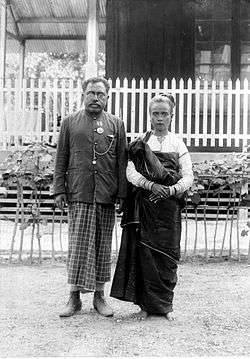Sika people
The Sika (also Sikanese, Sikka or Sara Sikka) people are an Indonesian ethnic group native to the region of east central Flores between the Bloh and Napung Rivers. In the city of Maumere, the center of the region, Sika people occupy a separate block.[2] The Sika language, which is a member of the Timor-Ambon language family, is spoken by the Sika people. The Sika language have at least three recognized dialects, namely Sikka Natar dialect, Sara Krowe dialect and Ata Tana 'Ai or Sara Tana 'Ai dialect.[3]
 Radja Don Josephus da Silva of Sika with his wife. | |
| Total population | |
|---|---|
| 237,000[1] | |
| Regions with significant populations | |
| Languages | |
| Sika language, Indonesian language | |
| Religion | |
| Christianity (predominantly), Folk religion | |
| Related ethnic groups | |
| Solorese |
History
Timorese Sika
A group of mestizo from Sikka and Europeans settled in 1851 as a voluntary recruits from the UK according to Sikka Dili over in Portuguese Timor.[4] In that year, the Portuguese government had José Joaquim Lopes de Lima to sign a treaty with the Netherlands concluded that the west of Timor, Flores island and other areas of the Lesser Sunda Islands are ceded to them. This agreement was later confirmed by the Treaty of Lisbon in 1859. The Sika people are formed in addition to the Bidau and Moradores as one of the three people groups that make up the Portuguese Armed Forces in the colony. All three ethnic groups lived in separate districts of the capital. As for language they still retained their original Malay language, but later switched to a Creole Portuguese. Today they have been absorbed into the same population and do not form their own distinct group anymore.[5]
Religion
The primary religion practiced by the Sika people is Roman Catholicism.[6] Sika people residing in the interior still retain their traditional ancestral worship and Agrarianism cult.
Culture
Sika people are part of the indigenous population of the Flores island.[7] The material culture of the mountaineers retained more traditional elements than on the coast, especially in the western part, where the Catholic mission worked actively since the 17th century; where it is here that their culture acquired European features.
Traditional activities
Sika people engage in slash-and-burn agriculture with short forms of shifting cultivation.[8] In the west of the coastal area, irrigation is used.[9] Food crops farming include rice, corn, cassava and millet; and other commodities are such as peanuts and coconut palm. Sika people also raise horses, small cattle and poultry. Coastal fishing is also common. Weaving and braiding are well developed.[10] Commodity-money relations are intertwined with numerous survivals of the traditional communal system, where it is manifested in the system of land ownership, regulation of marriages and in everyday life.
Lifestyle
Mountain villages are small and have a circular layout, are located on the steep slopes of the mountains; which served as protection against attacks. In the middle of the settlement there is an area with a temple and sacred megalithic shrines. Coastal settlements have a linear plan, located along a road or river. The dwelling frame and pillar structure, pile, in the mountains is designed for large families, while in the coastal areas, for a small family.
Clothing of the those living in the interior consists of a skirt or loincloth. In coastal villages, they carry kain (cloth) and a jacket or shirt.
The dietary of the Sika people are such as vegetable and mostly cereals from wheat and corn with spices, fruit and juice. Fish and meat are eaten on holidays.
References
- "Sikkanese in Indonesia". Joshua Project. Retrieved 2015-01-18.
- LeBar, Frank M.; Appell, George N. (1972). Ethnic Groups of Insular Southeast Asia: Indonesia, Andaman Islands, and Madagascar. Human Relations Area Files Press. p. 89. ISBN 08-753-6403-9.
- Tryon, Darrell T. (1995). Comparative Austronesian Dictionary: An Introduction to Austronesian Studies. Walter de Gruyter. ISBN 3-1108-8401-1.
- Thomas, Luis Filipe. "De Ceuta a Timor" [From Ceuta to Timor] (in Portuguese). Archived from the original on February 28, 2008. Retrieved 2015-01-17.
- History of Timor (PDF), archived from the original (PDF) on 2017-07-31, retrieved 2015-01-17
- "Sikka of Indonesia". PeopleGroup.org. Retrieved 2014-09-24.
- Susan Legêne; Bambang Purwanto; Henk Schulte Nordholt (2015). Sites, Bodies and Stories: Imagining Indonesian History. NUS Press. p. 183. ISBN 99-716-9857-9.
- Ongko Susetia Totoprajogo (August 1989). Effect of deworming treatment on nutritional status in primary school children in Kabupaten Sikka, Nusa Tenggara Timur Province, Indonesia. Cornell University. p. 20.
- Metzner, Joachim K. (1982). Agriculture and population pressure in Sikka, Isle of Flores: a contribution to the study of the stability of agricultural systems in the wet and dry tropics. Development Studies Centre Monograph No. 28. Canberra: Australian National University. pp. 221–224. hdl:1885/131368. ISBN 09-091-5059-1.CS1 maint: ref=harv (link)
- Jes A. Therik (1989). Tenun Ikat Dari Timur: Keindahan Anggun Warisan Leluhur / Ikat in Eastern Archipelago: An Esoteric Beauty of Ancestral Entity. Jakarta: Pustaka Sinar Harapan. p. 48. ISBN 97-941-6038-5.
Further reading
- Lewis, E. Douglas (2010). The Stranger-Kings of Sikka: With an Integrated Edition of Two Manuscripts on the Origin and History of the Rajadom of Sikka. Leiden: KITLV Press.CS1 maint: ref=harv (link)
- Lewis, E. D. (2009). "Precedence in the Formation of the Domain of Wai Brama and the Rajadom of Sikka" (PDF). In Vischer, Michael P. (ed.). Precedence: Social Differentiation in the Austronesian World. Canberra: ANU Press. doi:10.22459/P.05.2009.CS1 maint: ref=harv (link)
| Wikimedia Commons has media related to Sikka people. |